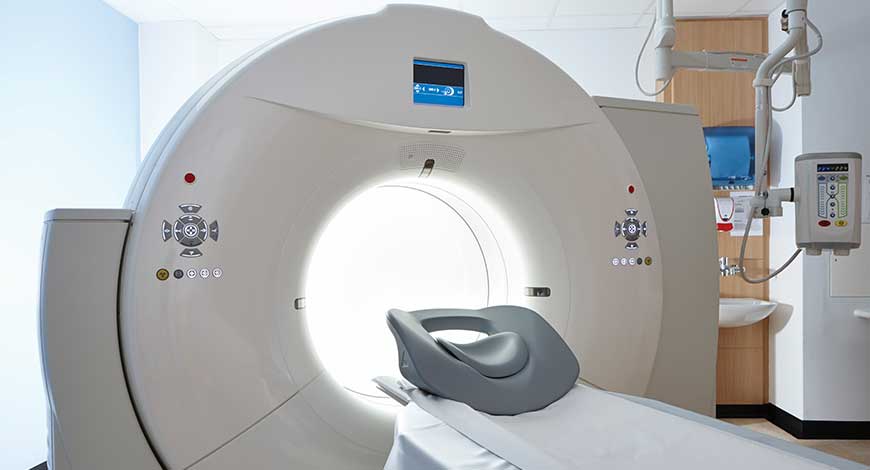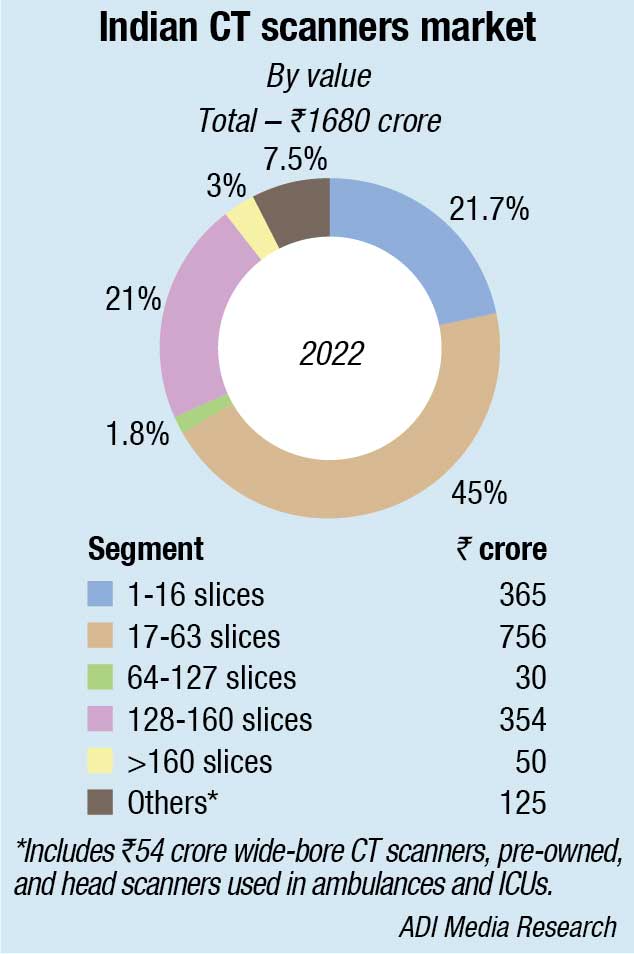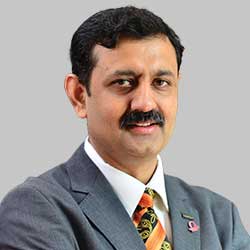CT Scanners
A steady CT scanners market ahead

With the pandemic behind us, when the Indian CT scanner market saw exponential growth in 2020 and 2021, 2023 onwards it is expected to grow at a steady 7 percent CAGR for the next five years.
In the ever-evolving landscape of healthcare, computed tomography (CT) scanners stand as a cornerstone, revolutionizing medical diagnostics worldwide. These advanced imaging tools have become integral in the dynamic field of medical imaging, fundamentally reshaping the industry. Market analyses and research publications collectively emphasize the profound impact of recent innovations in CT technology, providing a comprehensive insight into market dynamics and global trends. From groundbreaking gamma-ray CT systems to refined approaches in radiation dosimetry, and the exploration of nanomedicine for targeted imaging and therapy, the field continues to witness transformative developments.
Amidst this dynamic backdrop, industry insights from key players accentuate the potential of revolutionary technologies like photon-counting, ushering in a paradigm shift toward precision medicine. Simultaneously, the escalating demand for higher-slice CT systems propels the industry forward.
Intraoperative CT scanners and neurosurgical robots revolutionize surgical precision
 Prathamesh Durge
Prathamesh Durge
AGM – Radiology Division,
Schiller Healthcare India Pvt. Ltd.
In the field of neurosurgery, the combination of CT scanners and neurosurgical robots is bringing about a profound transformation. These innovations are not only reshaping the approach to complex procedures but also redefining the very essence of precision in minimally invasive surgical approaches.
Intraoperative CT (ICT) scanners provide real-time high-resolution three-dimensional imaging, significantly enhancing the precision and safety of various surgical interventions, particularly in neurosurgery, orthopedics, and vascular surgery. The primary function of intraoperative CT scanners is to offer dynamic – immediate – imaging in the operating room (OR). This real-time visualization empowers surgeons to make informed decisions, confirm the accuracy of their actions, and achieve optimal outcomes, making it an indispensable tool.
Neurosurgical robots are innovative technological tools that have revolutionized the field of neurosurgery. These sophisticated robotic systems are designed to aid neurosurgeons in performing intricate procedures with unparalleled precision, particularly in brain and spinal surgeries. One of the most significant benefits of neurosurgical robots is their ability to facilitate minimally invasive surgery. By using these robots in conjunction with real-time imaging techniques, such as intraoperative CT scans, surgeons can make smaller incisions, reduce blood loss, and promote faster patient recovery. This is particularly crucial in the context of deep brain stimulation for conditions like Parkinson’s disease, where pinpoint accuracy in electrode placement is essential.
In conclusion, the combination of intraoperative CT scanners and neurosurgical robotics is a leap forward in the field of neurosurgery. It not only enhances the precision and accuracy of procedures but also reduces the risk of complications, making surgery safer for patients. As these technologies continue to evolve and become more sophisticated, the future holds the promise of even more advanced and precise neurosurgical techniques. This constructive collaboration benefits the patients ultimately by providing them with the best possible surgical outcomes and by empowering surgeons with state-of-the-art tools to meet the challenges of intricate neurosurgical procedures. The collaboration between these innovative technologies is a testament to the ongoing evolution of medical practices and the pursuit of excellence in patient care.
Indian market dynamics
The Indian CT scanner market saw an exponential increase in 2020 and 2021, the machines having proven to be potent equipment in differentiating pneumonia caused by Covid-19 from other possible triggers. Additionally, CT scan machines were utilized to check how far the disease had progressed in the human body. In 2022, the demand started to normalize. The market is estimated at ₹1950 crore in 2021, and a decline to ₹1680 crore with 1245 units in 2022. A further decrease is anticipated in 2023, and the market is expected to close at ₹1380 crore. That said, the Indian market seems to be defying global trends; it may just spring a surprise over the next couple of years with so many new hospitals being planned, the number of cancer cases in India rising, increasing prevalence of tuberculosis, HIV, cancer, and other diseases, and increasing government investment into the healthcare infrastructure. Investments by the public and private bodies in neurology research are also on the rise.

AERB regulates radiation sources, impacting pre-owned CT scanner demand, while ultrasound and MRI, non-ionizing, escape AERB scrutiny, sustaining demand.
Some recent developments
In June 2023, Aarthi Scans & Labs, a pan-India integrated diagnostic chain, signed a strategic partnership with Siemens Healthineers. Under the partnership, Aarthi Scans will offer its artificial intelligence (AI)-based calcium scoring of the heart by CT scanning, which measures the amount of calcium deposition in the arteries supplying the heart.
|
Leading players in Indian CT scanners market |
|
| Tier 1 | Siemens & GE |
| Tier 2 | Philips, Canon and United Imaging |
| Others | Fujifilm, Toshiba, Hitachi and Medirays |
| ADI Media Research | |
In December 2022, Fujifilm India signed a partnership with Soorya Diagnostics LLP Center in Tirur Kerala, India. Under the partnership, Fujifilm installed its latest CT scan machine at Soorya Diagnostics Center to offer CT imaging and quality healthcare services to the patients of the city.
Global market scenario
The global CT scanners market size is estimated at USD 6.95 billion in 2023, and poised to reach USD 10.019 billion by 2030, at a compound annual growth rate (CAGR) of 5.6 percent.
The CT market saw a major boost in the Covid-19 pandemic, during which many hospitals purchased additional systems, but the introduction of technologically advanced computed tomography scanners is one of the major factors stimulating market growth.
Leading players innovate in CT scanning, cutting hospitalization time, enhancing cancer diagnosis, and improving market growth with safer, faster technology.
Recently, the market players have introduced higher-slice CT systems to enhance image quality, reduce scanning times, and eliminate stitching artifacts, which lead to the increase in the demand for CT scan services across the globe.
Emerging markets like Brazil, India, China, fueled by R&D, drive long-term growth in healthcare equipment.
Regional insights. Asia-Pacific stood at USD 2.4 billion in 2022 and is anticipated to grow at higher CAGR due to the increasing incidence of chronic diseases, developing healthcare sector, and strong unmet need for advanced diagnostic systems in diagnostic centers, which are the reasons for the region holding the largest chunk of the market share.
In 2022, North America secured the second-highest share in the global market.
Some of the prominent players operating in global CT scan market are GE Healthcare, Hitachi Ltd., Siemens Healthineers AG, Koninklijke Philips N.V., Neusoft Medical Systems, Canon Medical Systems Corporation, Carestream Health, Planmeca Oy, and Fujifilm Corporation.
Technological advances in CT scanning have ushered in a new era of precision and efficiency in medical diagnostics. Over the years, CT scanners have undergone transformative developments that extend beyond mere anatomical imaging. Breakthroughs in gamma-ray CT systems, innovations in radiation dosimetry, and the exploration of nanomedicine for targeted imaging and therapy reflect the dynamic landscape of CT technology.
The integration of photon-counting capabilities marks a significant milestone, promising improved image quality, reduced radiation exposure, and enhanced spectral imaging capabilities. The demand for higher-slice CT systems underscores the industry’s commitment to elevating diagnostic capabilities, allowing for more detailed and comprehensive scans.
Recent CT tech advances prioritize consistency, accuracy, and efficiency, reshaping medical imaging and fostering personalized medicine.
At the forefront of medical imaging innovation, Philips showcased its latest advances in CT technologies at the ASTRO 2023 in San Diego, USA, held in October. The focus is on precision radiation therapy planning, addressing the critical need for accuracy in cancer treatment, and emphasizes the synergy of clinical knowledge, anatomical and functional imaging, and radiation physics to enhance radiation therapy planning. Their MR and spectral CT solutions aim to consolidate these disciplines, offering comprehensive data that not only improves treatment accuracy but also streamlines workflows, enhances oncology department efficiency, and reduces the overall cost of care.
Photon-counting CT technology represents the next evolution in computed tomography, offering a leap forward in imaging capabilities. In contrast to traditional CT detectors, which indirectly transform X-ray photons into light and then into electrical pulses, photon-counting detectors directly convert X-ray photons into electrical signals.
Spectral photon-counting CT has promising applications in various medical fields. One notable area is k-edge and multi-contrast imaging, where having more than two energy bins enables multi-material decomposition. In oncology and cardiology, the technology shows potential for new applications, providing detailed information for improved diagnoses and clinical insights.
The elimination of electric noise in images, coupled with the ability to quantify the energy level of each photon, offers significant advantages. Smaller detector pixels further improve spatial resolution and eliminate down-weighting of lower-energy photons, enhancing image contrast, including the iodine contrast-to-noise ratio.
With its potential to substantially advance CT imaging, photon-counting technology stands poised to benefit millions of patients worldwide.
Higher-slice CT systems. Revolutionary 640-slice CT scanner offers rapid, comprehensive heart imaging, expediting diagnosis, reducing wait times, and facilitating prompt treatment.
Global research contributions in CT
The landscape of global research in computed tomography (CT) is marked by groundbreaking contributions, reflecting a commitment to advancing diagnostic imaging and therapeutic capabilities.
A gamma-ray CT system with a CdTe detector, featuring a 250-micrometer strip pitch, exhibits high accuracy and energy resolution, enabling precise material characterization.
CT scanners – Set for constant innovation
 Chandershekhar Sibal
Chandershekhar Sibal
Senior Vice-President & HOD of Medical Division,
FUJIFILM India
CT (computed tomography) scanners have become main choice of investigation after X-ray. CT scanner is taking X-rays across the patient body in 360 degrees. With advancement in technology, the scan time taken to rotate 360 degrees around the patient is reducing, thus enabling CT scanners to image heart. CT coronary angio procedures are increasing and making this a part of preventive healthcare check-up after age of 40 years; lowering the X-ray dose to patients has taken an important step for future developments.
One of the most striking aspects of modern CT scanners is their speed and accuracy. Advanced multi-slice CT scanners can capture multiple images within seconds, enabling swift and comprehensive assessments. This speed reduces examination times and minimizes patient discomfort by avoiding the need for repeated scans. Moreover, the integration of cutting-edge technologies has equipped CT scanners with enhanced diagnostic prowess, such as dual-energy CT for improved tissue differentiation and spectral imaging for enhanced contrast and tissue characterization. Moreover, the versatility of CT scanners is another characteristic that spreads across various medical specialties, from oncology and cardiology to neurology and emergency services. These systems aid in detecting diseases early, guiding appropriate surgical interventions, and monitoring treatment responses, thereby playing a pivotal role in patient care. Additionally, modern reconstruction techniques have significantly reduced radiation exposure from the procedures while not compromising image quality and prioritizing patient safety.
Looking forward, the trajectory of CT scanners is all set for constant innovation. Emerging technologies like artificial intelligence promise to revolutionize image reconstruction and interpretation, further enhancing diagnostic accuracy and efficiency.
Dual-energy computed tomography (DECT) transforms pulmonary imaging, enhancing lung function insights through dual X-ray energy levels. Offering detailed evaluations of perfusion and ventilation dynamics, DECT enables precise analysis of pulmonary disorders. Its clinical benefits span diverse patient populations, especially those with chronic respiratory conditions.
AI integration in CT scanners transforms medical imaging, streamlining radiological workflows. Advanced algorithms enhance diagnostic accuracy and expedite reporting. The synergy between AI and CT scanners revolutionizes diagnostic practices, emphasizing ongoing efforts for seamless integration and optimization in healthcare.
Future trends in CT imaging involve AI integration for enhanced reconstruction and faster processing, ensuring more accurate diagnoses. Advances also focus on dose management, prioritizing patient safety without compromising efficacy. Spectral CT enables improved tissue characterization and contrast agent visualization, leading to a more personalized and diagnostically robust future for CT technology.
Second Opinion:-
CT imaging technology – The new stethoscopes of the future.
Cybersecurity threats to CT scanners and their implications on patient well-being.












